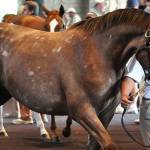Conformation in Thoroughbred Yearlings Studied

There is a belief among many people that defects in conformation predispose racehorses to poor performance and injury, and horses with obvious conformation problems tend to bring lower prices at public auction. Over the years, various studies of conformation faults and racing performance have produced contradictory results. For instance, one study showed horses that are back at the knee were more susceptible to carpal bone chip fractures, while other studies claim there is no such association. Another study found that horses that toe in were predisposed to gait interference, while another found that Standardbred trotters with this trait had better race times.
Regardless of causative factors, musculoskeletal injury remains the most significant cause of wastage in the racing industry, and identifying factors that could cause or prevent injury would benefit horses and humans. The aims of this study were to determine the prevalence and heritability of specific conformational defects in Thoroughbred sales yearlings and to investigate the association, if any, of defects with race results and injuries during the horses’ turf racing careers.
How was the study performed?
Over a period of seven years (1993-1999), 3916 Thoroughbred yearlings sold at public auction in England and Ireland were assessed for nine specific conformation traits. All assessments were done by a single veterinary observer using a fixed routine. Scores were given based on whether each trait was considered to be normal (score of 0) or defective (score of 1 to 3 indicating increasing severity of abnormality). Traits assessed were:
• Back at the knee (front leg curves backward when viewed from the side)
• Base narrow (hooves are closer together than distance between forelegs at the chest)
• Toed-in (hooves point toward each other rather than straight ahead)
• Toed-out (hooves point away from each other rather than straight ahead)
• Upright pasterns (pastern is too vertical when viewed from the side)
• Weak pasterns (pastern is too long and sloping when viewed from the side)
• Offset knees (cannon bone is not in line with forearm when viewed from the front)
• Weak hocks (hind cannon bone not vertical due to excessive hock angle)
• Tied in below the knee (leg circumference smaller below knee than above fetlock)
Using data on the sire, dam’s sire, and grandsire of each horse, a heritability index for each trait was determined. The heritability index described the proportion of total variation due to the average effects of genes. Software was used to estimate heritability of each trait from these variance components Durability was figured by listing the number of lifetime starts, number of starts as a two-year-old, and number of starts as a three-year-old. Racing performance was assessed on the basis of each horse’s mean and maximum British Horseracing Board (BHB) ratings, mean lifetime finishing position, number of wins, number of places, percent wins per start, and percent places per start. Effects of race distance were determined by categorizing the horses according to mean lifetime racing distance. Categories were sprinter (up to 7 furlongs), middle distance (mile to mile and a half), and stayer (distances of over a mile and a half).
What results were found?
Among the 3916 horses examined, the most common conformation defect was toed-out feet (30%), followed by toed-in feet (19.4%), upright pasterns (18.7%), base narrow (13.4%), and offset knees (12.9%). Weak pasterns, weak hocks, back at the knee, and tied in below the knee were found in less than 7% of horses. Defects were present in essentially the same proportion among the raced and unraced horses in the study, and there was no evidence of any difference in the proportion of horses with or without defects between the groups. There was considerable evidence for heritability of defects, with the traits of back at the knee and tied in below the knee showing the strongest genetic influence. Horses that were most severely toed-out, toed-in, or back at the knee tended to have somewhat lower mean and maximum BHB ratings as well as poorer lifetime finishing positions compared to horses without these defects or with less severe defects. However, there were no significant associations between conformation and career wins, career places, wins per start, or places per start. Horses with any conformation defect tended to have fewer starts as two-year-olds, but there was no significant association between conformation and either lifetime starts or three-year-old starts. There was also no significant relationship between conformation defects and racing distance category.
What does this tell us about the significance of conformation defects in Thoroughbred yearlings?
Conformation defects were shown to be more strongly associated with pedigree than with racing performance. It is difficult to separate the influence of training and other factors such as muscle type and cardiovascular and respiratory health from the effect of conformation on overall racing record. It must also be considered that horses with multiple or severe conformation defects might not be offered for sale, so there is some question as to whether the sample in this study is representative of all Thoroughbreds. Overall, in this study there was a lack of significant evidence to support an effect of conformation defects on racing performance, although both racing performance and prevalence of defects were very strongly linked to pedigree.
The full text of this paper was published in Equine Veterinary Journal, Vol. 38, No. 7 (2006), pp. 597-603. The study, “Prevalence, heritability and significance of musculoskeletal conformational traits in Thoroughbred yearlings,” was conducted by S. Love et al., Institute of Comparative Medicine, University of Glasgow.








